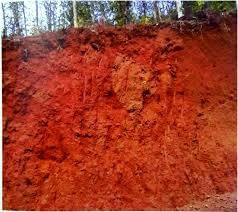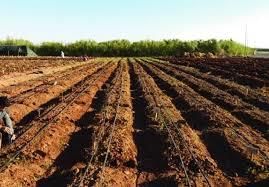GPSC (Goa) Exam > GPSC (Goa) Notes > Goa State PSC (GPSC) Preparation > Goa: Soils
Goa: Soils | Goa State PSC (GPSC) Preparation - GPSC (Goa) PDF Download
| Table of contents |

|
| Solis of Goa |

|
| Soil Types of North Goa |

|
| Soil Type of South Goa |

|
| Other Aspects related to Solis of Goa |

|
| Alluvial Solis of Goa (Around 11.7% area of Goa) |

|
Solis of Goa
- Soil Types: Goa has several main types of soil, including Coastal Alluvial soil, mixed red and black soil, laterite soil, and red sandy soil, which are further divided into 32 soil series.
- Predominant Soil Types:
- Laterites: 73.4%
- Alluvial & Marshy Soils: 11.7%
- Coastal Sandy Soils: 10.11%
- Saline Soils: 4.79%
- Soil pH: The pH of Goa's soils ranges from 4.5 to 6.5.
- Soil Quality: The soils in Goa generally have good organic matter content and respond well to the application of nitrogen (N) and phosphorus (P) fertilizers.

Soil Types of North Goa
Solis of Goa of the district can be classified into 3 types namely:
- Laterite Soil:
- Characteristics: This is the predominant soil type in the district. It is highly porous and permeable, slightly acidic with low pH values. It is low in organic matter, calcium, and phosphorus.
- Saline Soil:
- Occurrence: Found in the flood plains of the Zuari and Mandovi rivers in Tiswadi, Bardez, and Ponda taluks, and also in Pernem taluk.
- Characteristics: This soil is deep, poorly drained, and less permeable. It is saline, has high pH, and contains humus and organic matter.
- Alluvial Soil:
- Occurrence: Appears as a thin strip along the coastline in the western part of the district.
- Characteristics: It is reddish-brown to yellowish, coarse-grained, and confined to narrow river valleys. The soil is well-drained, acidic with low pH, and has low organic content.
Soil Type of South Goa

Solis of Goa of the district can be classified into 4 types namely:
- Lateritic Soil:
- Characteristics: Major soil type in the district, highly porous and permeable. Slightly acidic with low pH values and low in organic matter, calcium, and phosphorus.
- Saline Soil:
- Occurrence: Found in the flood plains of the Zuari, Sal, Saleri, Talpona, and Galjibagh rivers in Salcete, Mormugao, Quepem, and Canacona taluks, and to a limited extent in Sanguem taluk.
- Characteristics: Deep, poorly drained, and less permeable. Saline with high pH, containing humus and organic matter.
- Marshy Soil:
- Occurrence: Predominantly in Salcete taluk and the western part of Canacona taluk, and also in Mormugao taluk.
- Characteristics: Found in low-lying, waterlogged, and tidal-affected areas.
- Alluvial Soil:
- Occurrence: Appears as a thin strip along the coastline in the western part of Salcete taluk and to a limited extent in Canacona taluk.
- Characteristics: Reddish-brown to yellowish, coarse-grained, confined to narrow river valleys. Well-drained, acidic with low pH, and low in organic content.
Question for Goa: SoilsTry yourself: Which type of soil is the predominant soil type in North Goa?View Solution
Other Aspects related to Solis of Goa
Related to Salinity Aspects
- In coastal rice production areas of Goa, which constitute 30% of the net cultivated rice area and are locally known as Khazan lands, salinity is a common soil issue.
Here are the key characteristics of these soils:- Elevation and Water Table: The lands are characterized by low elevation and a high water table.
- Soil Texture: The soils are deep and have a heavy texture, ranging from silty clay to silty clay loam, with a heavier sub-horizon.
- Soil pH: Slightly acidic to neutral, ranging from 6.0 to 7.0.
- Electrical Conductivity: Ranges from 4 to 15 dS m⁻¹.
- Organic Carbon Content: Between 6.3 to 7.7 g kg⁻¹.
- Salinity levels typically exceed the critical level (>4 dS m⁻¹) from January to June, peaking between March and May, and then decline through December.
Laterite Solis of Goa(73.4% Area of Goa)
- Origin of the Name: The term "laterite" comes from the Latin word ‘Later,’ which means brick. When wet, these soils are soft like butter but harden and become cloddy upon drying. Consequently, they are often used as bricks in construction.
- Formation: Lateritic soils typically form on high, flat erosion surfaces in regions with high (>200 cm) and seasonal rainfall. The alternating wet and dry seasons cause the leaching of siliceous matter from the rocks, leaving behind iron and aluminum compounds. These soils are classified as zonal soils.
- Distribution: In Goa, lateritic soils are prevalent in about 73% of the area, particularly in the higher regions of the Peninsular Plateau.
- Soil Color: They are reddish-brown due to the presence of iron oxide.
Other characteristic features
- Soil Formation: Rainfall leaches away lime and silica from the soil, leaving behind iron oxide and aluminum compounds, which give the soil its reddish-brown color. Additionally, high temperatures accelerate the removal of humus by bacteria.
- Fertility: Lateritic soils are generally low in fertility as they represent the final stage of soil decomposition. They are often poor in organic matter, nitrogen, phosphate, and calcium, while iron oxide and potash are in excess.
- Physical Characteristics: A notable feature of lateritic soils is their pebbly crust, which forms due to the alternation between wet and dry periods.
- Soil pH: These soils tend to be acidic because of leaching.
- Fertility Improvement: To enhance fertility for cultivation, the application of manures and fertilizers is necessary.
Suitable crops: Cashewnut.
Alluvial Solis of Goa (Around 11.7% area of Goa)
- Formation: Alluvial soils are derived from debris brought down from the Himalayas or silt left behind by retreating seas, making them azonal soils.
- Areas: They cover about 11.7% of Goa.
- Soil Texture: These soils vary from sandy loam to clay.
- Soil Color: The color ranges from light grey to ash grey, influenced by the depth of deposition, texture, and maturity of the soil.
- Other Characteristics:
- Nutrient Content: They are typically low in nitrogen, phosphorus, and humus but rich in potash and lime.
- Soil Profile: Lacks stratification.
- Cultivation: Alluvial soils are intensively cultivated and may be covered with unproductive wind-borne soil called loess in some areas.
- Limitations:
- Water Drainage: These soils allow water to sink into lower strata.
- Nutrient Deficiency: They lack nitrogen but can rapidly fix nitrogen through leguminous crops like peas, beans, and cloves.
- Suitable Crops: Alluvial soils support a variety of crops including wheat, rice (mainly in Goa), maize, sugarcane, pulses, oilseeds, fruits, vegetables, and leguminous crops.
The document Goa: Soils | Goa State PSC (GPSC) Preparation - GPSC (Goa) is a part of the GPSC (Goa) Course Goa State PSC (GPSC) Preparation.
All you need of GPSC (Goa) at this link: GPSC (Goa)
FAQs on Goa: Soils - Goa State PSC (GPSC) Preparation - GPSC (Goa)
| 1. What are the main soil types found in North Goa? |  |
Ans. The main soil types found in North Goa include laterite and red soils.
| 2. What is the predominant soil type in South Goa? |  |
Ans. The predominant soil type in South Goa is sandy soil.
| 3. How much of Goa's area is covered by alluvial soils? |  |
Ans. Around 11.7% of Goa's area is covered by alluvial soils.
| 4. What are some other aspects related to the soils of Goa? |  |
Ans. Other aspects related to the soils of Goa include their influence on agriculture, vegetation, and water retention.
| 5. What is the role of Goa Soils GPSC in managing and studying the soils of Goa? |  |
Ans. Goa Soils GPSC plays a crucial role in managing and studying the soils of Goa, providing valuable information for agricultural practices and environmental conservation.
Related Searches














